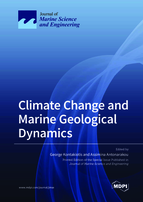Climate Change and Marine Geological Dynamics
A special issue of Journal of Marine Science and Engineering (ISSN 2077-1312). This special issue belongs to the section "Geological Oceanography".
Deadline for manuscript submissions: closed (30 April 2021) | Viewed by 27233
Special Issue Editors
Interests: marine geology; climate changes; paleoceanography; geochemistry; petroleum geology; basin analysis; sapropels; coastal and open marine systems; environmental reconstruction; marine sediment dynamics
Special Issues, Collections and Topics in MDPI journals
Interests: paleoclimatology; paleoceanographic proxies; micropaleontology; integrated stratigraphy; marine geology; ocean dynamics; sea-level changes; marginal seas; astronomical frequencies in paleoclimates; extreme geological events
Special Issues, Collections and Topics in MDPI journals
Special Issue Information
Dear Colleagues,
The tendency for climate to change has been one of the most surprising outcomes of the study of Earth history. Marine geosciences (including marine geology, sedimentology, geochemistry, paleoceanography, paleontology) can record valuable information about past environment, climate, and biota just before, during, and after each climate perturbation. Particularly, certain intervals of the geological record are windows to key episodes in the climate history of the Earth‑life system. Marine geological dynamics such as sea‑level changes, environmental parameters, sedimentary cyclicity, and climate are strongly related through a direct exchange between the oceanographic and atmospheric systems. This Special Issue aims to provide an overview of the interplay of these processes across a variety of settings (coastal to open marine) and timescales (early Mesozoic to modern). Among the priorities are the hydroclimate reconstructions using integrated geochemical and/or paleontological proxies measured from different natural archives. We also encourage contributions outlining the applications of novel techniques that provide important information on this topic.
Dr. George Kontakiotis
Prof. Dr. Assimina Antonarakou
Guest Editor
Manuscript Submission Information
Manuscripts should be submitted online at www.mdpi.com by registering and logging in to this website. Once you are registered, click here to go to the submission form. Manuscripts can be submitted until the deadline. All submissions that pass pre-check are peer-reviewed. Accepted papers will be published continuously in the journal (as soon as accepted) and will be listed together on the special issue website. Research articles, review articles as well as short communications are invited. For planned papers, a title and short abstract (about 100 words) can be sent to the Editorial Office for announcement on this website.
Submitted manuscripts should not have been published previously, nor be under consideration for publication elsewhere (except conference proceedings papers). All manuscripts are thoroughly refereed through a single-blind peer-review process. A guide for authors and other relevant information for submission of manuscripts is available on the Instructions for Authors page. Journal of Marine Science and Engineering is an international peer-reviewed open access monthly journal published by MDPI.
Please visit the Instructions for Authors page before submitting a manuscript. The Article Processing Charge (APC) for publication in this open access journal is 2600 CHF (Swiss Francs). Submitted papers should be well formatted and use good English. Authors may use MDPI's English editing service prior to publication or during author revisions.
Keywords
- Earth’s orbital sedimentary cyclicity (e.g., sapropels) and its relationship with climate;
- Hydrological‑sedimentological regime and biotic response to climate‑induced extreme geological events (e.g., MSC, MMCO, PETM);
- Controls of climate to carbon and water cycles;
- Application of geochemical (e.g., TEX86, Uk’37, Mg/Ca, Sr/Ca, Δ47) and paleontological (e.g., corals, foraminifera, nannofossils, otoliths, bivalves, speleothems) proxies to reconstruct environmental parameters (e.g., SST, SSS);
- Monitoring and modeling the climate system;
- Marine petroleum geology and exploitation of natural energy resources (e.g., hydrocarbons, gas/oil, methane, mud volcanoes);
- Paleoceanographic evolution and paleoclimatic changes along both latitudinal and longitudinal gradients;
- Impact of climate change on open ocean and marginal marine ecosystems;
- Natural and human (e.g., ocean acidification, water pollution, abnormal foraminiferal types) environmental stressors in marine sedimentary basins;
- Sea level indicators in Late Quaternary and paleogeographical reconstructions.







